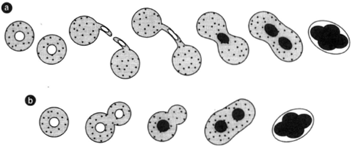Yeasts
 |
| Figure 19-5 Yeasts in the process of budding and fission |
The classification of yeasts as: Ascomycetes is surprising because the yeasts are known for reproducing by budding. The yeast cell typically develops a bud on the side, the nucleus divides, and a daughter nucleus migrates into the bud. The cells may either divide to from two separate cells or remain attached to each other. This asexual process of budding can occur when the nuclei are haploid or when they are diploid.
 |
| Figure 19-6 Two methods of sexual union of nuclei in yeasts. (a) Two cells come together to form a diploid nucleus, which then produces ascosporebsy meiosis. (b) A nucleus divides and the two daughter nuclei then fuse again to produce a diploid condition. Ascus formation follows. |
Under certain circumstances, ascus formation is noted in yeasts, however. Either two yeast cells come together and fuse to form a diploid nucleus (figure 19-6a), or one yeast cell buds, the nucleus divides, and the two daughter nuclei come together again to fuse (figure 19-6b). Both cases result in a diploid condition. These events can be followed by meiotic nuclear divisions within the cell, resulting in a tetrad of four haploid meiospores or ascospores (although the typical number of spores produced in ascomycetes is eight). In yeasts, ascospores are produced in a rounded ascus rather than an elongated, saclike structure. One of the traits of yeasts is that they do not produce a mycelium.
This is uncommon among ascomycetes.
Saccharomyces cerevisiae is a yeast of great economic importance, mainly due to the kinds of enzymes it produces. Enzymes are proteins that enable and improve chemical reactions. They are highly specific; it takes a certain kind. of an enzyme to act on a certain kind of substance to yield a certain kind of chemical reaction. Zymase, which occurs in yeast cells, converts glucose into ethyl alcohol and carbon dioxide. Invertase, another yeast enzyme, converts sucrose into fructose and glucose.
Yeasts are used in the alcoholic fermentation of sugars, breaking down the sugars into carbon dioxide and alcohol or, if oxygen is present, into carbon dioxide and water. In going through fermentation, baker’s yeast is inhibited in its activity when the alcohol content reaches 4 or 5 percent. In a sense, this is a disadvantage to the yeast because alcohol formation slows the growth of the organisms. It is easy to see that by their forming alcohol they have built the cause of their own demise. Brewer’s yeast, on the other hand, is a strain of Saccharomyces cerevisiae in which growth is able to continue until the alcohol content reaches between 14 and 17 percent. Different strains of yeast react differently.
When a mole of sugar is decomposed into alcohol and carbon dioxide by yeast and in an anaerobic environment, 28,000 calories of energy are liberated. If the environment is instead aerobic, the end products are carbon dioxide and water and the amount of energy liberated is 674,000 calories.
Aside from Saccharomyces cerevisciae, the yeast of the brewing industry, other species of Saccharomyces are used in making other beverages including sake, ginger beer, rum, and wine. Saccharomyces is also rich in vitamin B and protein (composed of approximately 50 percent), making it a nourishing feed for livestock. During World War II, thousands of tons of yeast were produced in Germany as a source of protein. Suitable methods of yeast production for protein manufacture could make yeasts valuable resources for third world countries.
Not all species of yeast deserve the high accord given Saccharomyces cerevisiae. Some species are pathogenic, causing skin and lung diseases others cause blastomycosis, an invasion of yeast like cells in the skin, mucous membranes, lungs, and, sometimes, internal organs.




